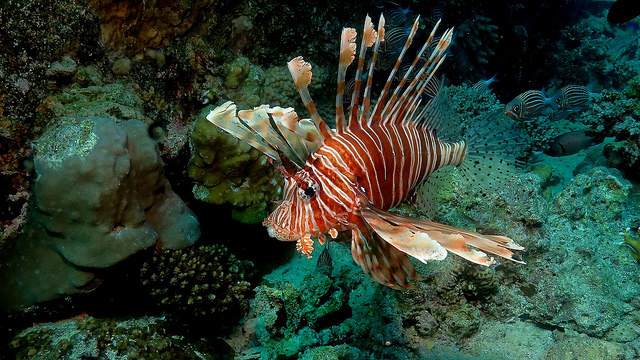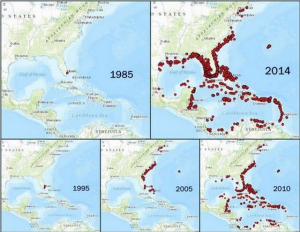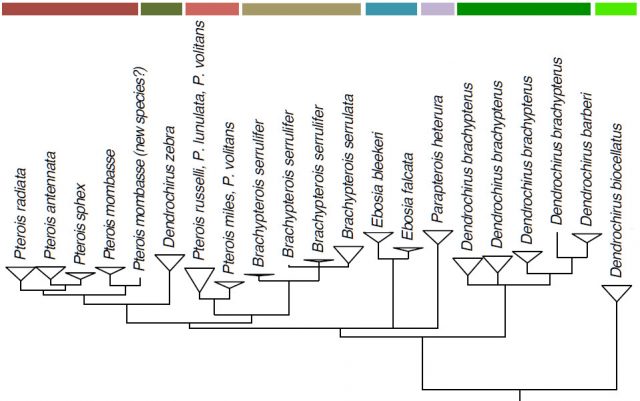
Pterois miles seen in the Red Sea. Credit: Antje Schultner
The Volitans Lionfish has been in the news a lot recently, as this gluttonous Indo-Pacific fish has been slowly eating its way across the Caribbean, leaving ecological devastation in its wake. But it seems we may have gotten one important fact wrong about this species… it might not really be a species at all.

Lionfish sightings, 1985-2014. Source: US Geological Survey/Florida Fish and Wildlife Conservation Commission
Until recently, our understanding for how best to classify lionfishes had been restricted to comparing morphological traits, which fundamentally limits our understanding for how best to classify the two dozen or so recognized species in this group. And nowhere was this more evident than with the nearly indistinguishable species complex centered on the familiar Red Lionfish Pterois volitans, which includes other purported relatives such as P. miles, P. russelii, P. lunulata, P. andover, and P. kodipungi. If you’ve ever tried identifying one of these larger lionfishes to species level, you’ve likely been struck by just how daunting the task is—counting fin rays and lateral line scales is not everyone’s cup of tea, and even these diagnostic traits are rather variable and overlapping.

Phylogeny of Pteroinae from nuclear DNA. Modified from Wilcox 2014
The recently completed dissertation of Dr. Christie Wilcox is challenging many of our preconceived notions concerning these poorly understood species. In her thorough genetic and morphological study of the lionfish Subfamily Pteroinae, she found little support for the traditional classification. Previously, this group was principally divided between those species with unbranched pectoral fin rays (which includes the larger lionfishes familiar to aquarists, Pterois), while smaller species with branched pectoral fin rays found themselves placed in Dendrochirus, home to the Fuzzy Dwarf, Zebra and Fu Manchu Lionfishes. What this new study has determined (in accord with some earlier findings) is that neither genus is accurately portraying the true evolutionary history of these fishes.
As it relates to the Volitans Lionfish, instead of the half-dozen different species suggested by ichthyologists, there may be just a single widespread clade (or species) which can be further subdivided into separate Indian and Pacific Ocean populations. These differ by a small (but meaningful) amount in their genetics, similar to what we find in other geminate species pairs in the region. There are also subtle morphological differences that can be useful for identifying unknown aquarium specimens, summarized in the table below.
Despite the morphological and genetic distinctions, it’s not entirely clear that there isn’t just one “species” here, as the specimens found as far east as Polynesia can show evidence of the Indian Ocean genetic haplotypes. This sort of permeable genetic boundary is a murky grey area hinting at the complexities present in the evolutionary histories of these fishes. There is little doubt that the two oceanic populations have been repeatedly isolated due to changes in sea level over the past 2-4 million years, but the most relevant question to ask is how meaningful is their separation from each other now. Is this group still functionally acting as separate biological species, or are they instead interbreeding and mixing their genes like little piscine mutts.
If we assume there are separate “species”, then the Indian Ocean population can be confidently identified as Pterois miles, while the Pacific sister species is of a more uncertain taxonomic affinity. Pterois volitans, first described by Linnaeus in 1758, would be the oldest name and thus have priority, but Wilcox argues that this fish is in fact a hybrid of P. miles and the true Pacific species, as its morphology and genetics have affinities to both oceanic populations. This is relevant to the invasive Caribbean population, as most specimens appear to be of this hybrid form, with just a small number being identifiable as pure P. miles.
https://youtu.be/Amv2ZyM_Y5c
- The video above shows specimens with 14 pectoral rays (first) and 13 pectoral rays (second). Note that the latter has spotted fins, which could indicate a 13-ray hybrid or a particularly spotted P. lunulata.
Of the remaining suspects, P. russelii is the next oldest name, but this fish was described from specimens collected in India, suggesting that this clear-finned phenotype was merely a variation of P. miles and not our Pacific lionfish. This brings us to Pterois lunulata—a fish described in 1843 from Japan and which has more often than not been treated as a synonym of russelii. However, none of this is really binding in any way, and, should this group be revised, the authors may just petition to keep the name P. volitans in place for this Pacific “species” or for the Indo-Pacific population as a whole.
We won’t know for a little while longer what to make of this exciting new research until it is formally published in peer review, but there are many significant changes which are likely in store for some familiar fishes. For instance, it appears that the true Pterois lionfishes (represented by the group we opined upon previously) are only distant relatives to the other taxa that have traditionally been grouped alongside them. This means that the Antennata, Radiata and Mombasa Lionfishes may soon be placed into their own genus, likely “Pteropterus”.
- The morphology and location (Sri Lanka) of the specimen in this video indicates this is P. miles
And another major change may be coming to the various dwarf lionfishes in Dendrochirus, which have been shown to represent a highly artificial grouping. The Zebra Lionfish is apparently a closer relative to the “Pteropterus” group than to any of the other smaller species with which it has traditionally been placed, meaning the name Dendrochirus may soon only apply to D. zebra. The Fuzzy Dwarf Lionfish (D. brachypterus) and the Hawaiian Lionfish (D. barberi) appear as close relatives of P. miles and company, while the very odd Fu Manchu Lionfish (D. biocellatus) may represent a very isolated lineage that diverged early on in the evolutionary history of the lionfish clade. This fish has previously been placed by itself in Nemapterois, and this may be its ultimate fate once again.
That such large and charismatic fishes could be so misunderstood for such a long period of time is surely a testament to just how challenging and complex this group is. Rather than a simple evolutionary story, it seems evident that lionfishes have arrived upon similar morphologies in several independent instances. Now, with Dr. Wilcox’s research set to be published soon, we’ll finally be getting a detailed look into the origins of this fascinating and important lineage of marine life.











0 Comments